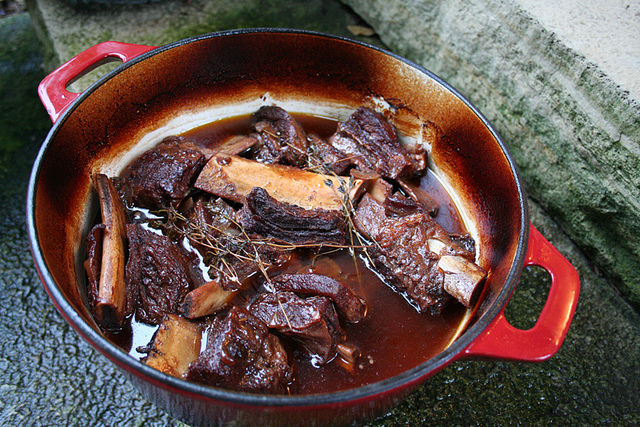Week IV: Moist Heat Cooking
(Intro; Week I: Knife Skills; Week II: Eggs; Week III: Soups and Stocks)
There was a noticeable change yesterday when I stepped into my kitchen with a shopping bag full of ingredients and The Packet in hand. I felt a level of calmness and confidence that was a little foreign to me, but certainly welcomed. I didn’t experience the familiar waves of panic nor did I have thoughts of how everything will go wrong. My mom wasn’t even home during this particular cooking endeavor, and I usually enjoy the comfort of knowing she’s around to put out the fire if need be (literal and figurative meanings apply).
And all this positivity even after a botched rabbit.
I wasn’t sure until Sunday’s class at CSCA what moist heat cooking was, and maybe you don’t either. It means cooking with moisture (duh). So steaming, braising, stewing, simmering, boiling, and poaching fall into this category.
In The Packet this week were meats like veal, pork, beef, sea bass and…rabbit. Maybe not the most practical of choices, but I had to go for it. Myself and another curious student decided to tackle together the unfamiliar meat in order to make Fricassee de Lapin (rabbit).
Something to remember: the beauty of braising is that the longer you leave the meat alone, the better it will taste. So, walk around, do some errands, and just let it do its thing for at least an hour and a half.
Unfortunately, when you’re standing in a cramped kitchen with semi-strangers and no distractions, literally watching the pot boil, it isn’t long before you get antsy. My partner and I jumped the gun by about fifteen minutes and prematurely took the rabbit out of the oven, feeling the pressure as other groups were plating. The creamy sauce was excellent, but the meat was not nearly as fall-off-the-bone tender as it should have been.
Another pair got it right with their Braised Short Ribs with Dried Cherries. It was tangy, sweet, moist, juicy and all those other descriptives I would use if my culinary vocabulary were more advanced. I had to make this dish at home, and I wasn’t in the least bit perturbed by our rabbit because I knew what we’d done wrong. Apparently, patience is also a main ingredient in any recipe.
If you have time on your hands and some meat-loving friends, invite them over for dinner and Make. This. Dish. It’s easy and sure to please.
(I won’t be reporting on next week’s class, Dry Heat Cooking, as I’ll be running a half marathon instead. Eek.)
Braised Short Ribs with Dried Cherries
¼ cup extra virgin olive oil
12 2-inch long pieces of beef short ribs (about 5 pounds)
Salt and pepper
1 ½ cups of Rhone or Cabernet Sauvignon red wine
¼ cup of all purpose flour
1 quart of chicken stock
1 ½ tsp. of salt
8 garlic cloves, peeled
8 shallots, peeled
1 ¼ cup of dried sour cherries
Preheat oven to 325º
In a large enamel casserole, heat the oil and brown the ribs in batches over moderate heat. Season with salt and pepper. Pour out excess oil from the casserole, add the wine and deglaze the pan over high heat, scraping up all the browned bits with a wooden spoon on the bottom of the pan. Reduce wine to ¾ cup.
Stir in the flour to make a paste. Gradually add the stock and whisk until smooth. Return the ribs to the pot with any accumulated juices. Place a piece of parchment paper and an inverted lid of foil over the ribs, cover, bring to a simmer, and cook in oven for 1 ½ hours. (NOW, this is me talking, not the recipe. We did this parchment paper method in class, but I didn’t have any at home so I just eliminated this step and covered the pot with the lid as usual. Still came out nice and tender.)
Remove the lid and foil (cough) and add 1 ½ tsp. of salt, garlic, and shallots, cover with foil and lid and cook an additional hour. Once again remove the lid and foil, add the cherries, partially cover, and simmer on stove over low heat until the ribs are very tender and a skewer inserted in the meat comes out without any resistance.
With a slotted spoon transfer the ribs, garlic, shallots, and cherries to a plate. Strain the cooking juices into a large heat resistant measuring cup. Let set. Within 5-10 minutes, the fat will have come to the top and separated from the liquid. With a bulb baster, squeeze the bulb, keeping it closed. Siphon off only the cooking liquid at the bottom of the measuring cup, leaving the fat behind and return the defattened juices to the casserole.
Simmer the sauce for 5 minutes to concentrate the flavors. Return the ribs, garlic, shallots, and cherries to the casserole. Season with salt and pepper and serve.
(Roberta L. Dowling © 2003)


This dish would appease both my husband and myself – beef for him, dried cherries & red wine for me!
Pingback: The Return of Rabbit | Public Radio Kitchen | Blogs | WBUR